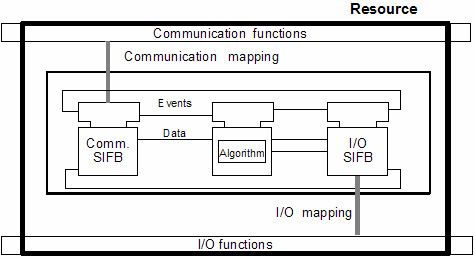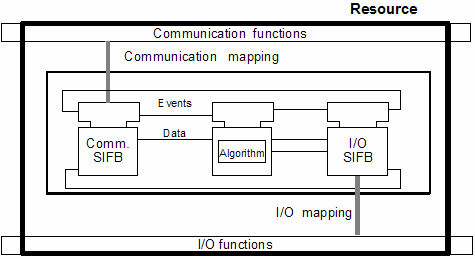What is IEC 61499?
IEC 61499-1 defines an
open architecture for distributed and embedded control and automation. In conjunction with an appropriate
compliance profile as defined in
IEC 61499-4 and
software tools meeting the requirements of
IEC 61499-2, reusable software modules (
function blocks) can be developed and deployed in distributed systems that will meet the requirements of:
- portability: Software tools can accept and correctly interpret software components and system configurations produced by other software tools.
- interoperability: Embedded devices can operate together to perform the functions needed for distributed applications.
- configurability: Any device and its software components can be configured by software tools from multiple vendors.
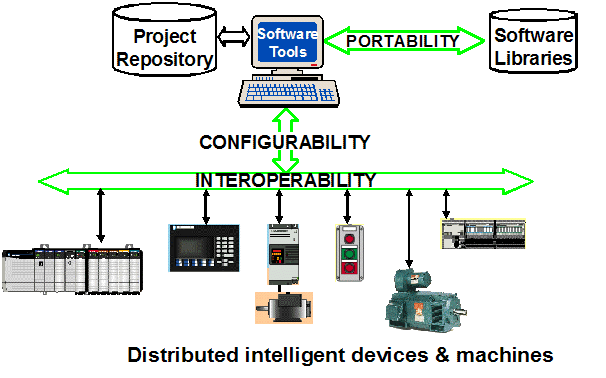
Encapsulation
Function Block Types
In the
IEC 61499 standard, the basic unit for encapsulating and reusing Intellectual Property (IP="know-how") is the
function block type. In object-oriented terms, this is a
class defining the behavior of (possibly) multiple
instances. It includes
event inputs and outputs as well as the more traditional
data inputs and outputs, to provide for synchronization between data transfer and program execution in distributed systems.
.gif)
Basic Function Blocks
As its name implies, the
basic function block type is the "atom" out of which higher-level "molecules" are constructed. With IEC 61499 compliant
software tools, software developers can
encapsulate IP in the form of
algorithms written in
Java or the
IEC 61131-3 programming languages. Execution of these algorithms is triggered by
Execution Control Charts (ECCs), which are event-driven state machines similar to the well-known
Harel Statecharts.
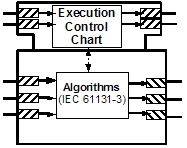
Service Interface Function Blocks
Another "atomic" function block type is the
service interface function block (SIFB) type. This represents the interface to low-level services provided by the operating system or hardware of the embedded device, such as:
- Graphical User Interface (GUI) elements such as a slider (illustrated below), knob or pilot light
- Communication services (the CLIENT_2 SIFB illustrated below is a communication "client" for a remote "server")
- Interfaces to hardware such as a temperature sensor, a motor speed controller, a control valve or a room light intensity controller.
IEC 61499-compliant
software tools and and their associated runtime packages provide a large selection of GUI and communications SIFBs. Providers of
hardware SIFBs (typically the
manufacturers of embedded devices) can use IEC 61499-compliant software tools to document how they work in the form of
service sequence diagrams.

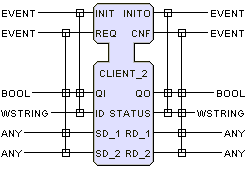
Reuse
Software developers can use IEC 61499-compliant
software tools to build higher-level function block "molecules" called
composite function block types out of lower-level function block "atoms" (
component function blocks). This is done by specifying the event and data interfaces of the composite type, then filling it with a diagram showing how its internal component function blocks are connected. In this kind of function block, execution of the algorithms in the component function blocks is controlled by the flow of events from one component to another.
Distribution
In the
IEC 61499-1 architectural model, distributable
applications are built by interconnecting instances of reusable
function block types with appropriate event and data connections,in the same manner as designing a circuit board with integrated circuits. Using IEC 61499-compliant
software tools, these function blocks can then be
distributed to physical
devices across a network, as long as these devices comply with the applicable
compliance profile.
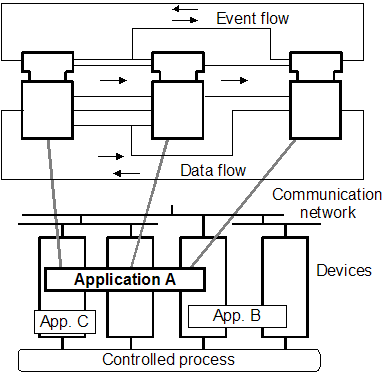
It is also possible to distribute an application across multiple
resources within a
device. Resources might be multiple processors plugged into a backplane, or multiple tasks within a single processor with a multitasking operating system. In the example shown below, pieces of Application A run in Resources
x, y and
z, as well as other devices in the system; pieces of Application B run in resource
z and in other devices; and Application C runs "locally" in Resources
x and
y.
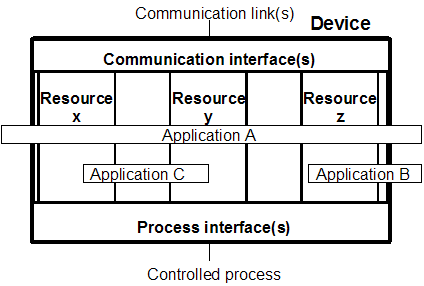
Integration
In the
IEC 61499 architecture,
resources are the workhorses that provide the services needed to integrate all the pieces of applications into a working distributed system. IEC 61499-compliant
software tools can be used to:
- Map the messages that are passed back and forth between devices into the input and output events and data of communication service interface function blocks (SIFBs).
- Use event and data inputs and outputs to trigger the performance of the algorithms of basic and composite function blocks, and synchronize their operation with other function blocks
- Map the data and event inputs and outputs of I/O SIFBs to the inputs and outputs of the system, where it can sense what is going on in the physical world and take appropriate physical actions in response.
Example 1: Processing a message
In the example shown below:
- A message arrives from another resource (possibly in a remote device) via the communication interface.
- The resource maps the data in the message into a data output of the communication SIFB, which is wired to the data input of a basic function block; the resource then issues an event from the SIFB, which is propagated to an event input of the basic FB.
- The arrival of this event causes the resource to execute the basic FB's algorithm, which uses the value of the data input to produce new values for the data outputs, which are wired to an I/O SIFB.
- The resource then issues an event from the basic FB, which is propagated to an event input of the I/O SIFB.
- The arrival of this event at the SIFB causes the resource to perform an appropriate action (start or stop a motor, set a room light level, etc.), based on the data input values of the SIFB.
Example 2: Processing an Input Event
In the example shown below:
- Something happens at an input interface (a user turns a knob, a limit switch senses the presence of a package on a conveyor, etc)., which causes the resource to map the input data to an output of the I/O SIFB.
- The resource maps the input data into a data output of the I/O SIFB, which in this case is wired to the data input of a communication SIFB. The resource then issues an event from the I/O SIFB, which is propagated to an event input of the communication SIFB.
- The arrival of this event at the communication SIFB causes a message containing the input data to be sent to a resource somewhere else in the system.
Configuration
IEC 61499-compliant
software tools can be used according to the following procedure to
configure distributed control and automation systems from libraries of reusable IEC 61499-compliant components:
- Configure the devices in the system: their names, types, parameters, and network interconnections.
- Configure the name, type and parameters of each resource in the devices.
- Build the required application functionality in each resource by adding and interconnecting function blocks from a library of function block types and setting their parameters as necessary.
- Add the communication service interface function blocks (SIFBS) necessary for proper transmission of data and synchronization of operations among resources, set their parameters and interconnect them as needed with the application function blocks.
Software Tools
Following is a list of IEC 61499-related software tools known to the author. Such tools should meet the requirements defined in
IEC 61499-2, and should also have their characteristics defined in a
Compliance Profile as specified in
IEC 61499-4.
Books
Links

.gif)






